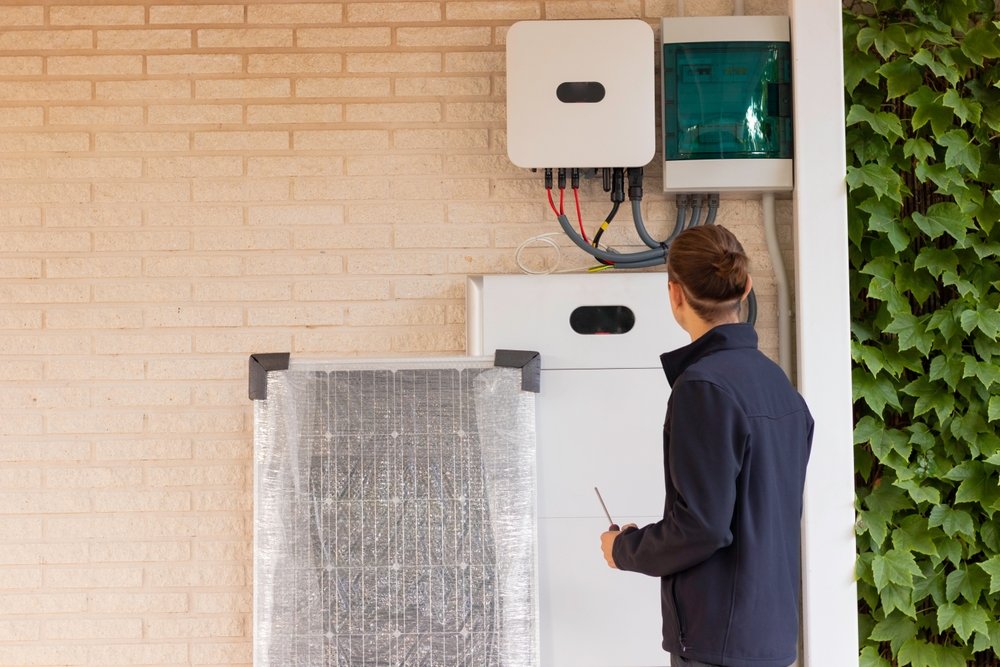Yes, it is possible to install additional solar batteries to an existing solar system. However, the installation complexity depends on how your system was initially developed to accommodate batteries. Mainly, homeowners prefer adding batteries to provide backup during power outages, energy independence, cost savings, and sustainability.
Solar batteries store the energy generated by solar panels by converting sunlight into electricity. The direct current (DC) gets converted into an alternating current (AC) with the help of an inverter. Your home appliances are powered by using AC electricity and any additional electricity generated or not utilized by your appliances are used to charge your batteries. During nights, power outages, or cloudy days, your appliances get powered by the stored energy in your battery.

If you’re looking for the best ways to improve your solar energy system, adding batteries can be an important step. Most importantly, you need to consider the essential factors before adding solar storage batteries, select the right solar battery for your system, and the steps to combine them effectively. Let’s find out if installing batteries can be beneficial for you or not.
Why Add Batteries to a Solar System?
Despite the huge upfront costs, adding batteries to a solar system can be highly beneficial in promoting energy independence by storing excess electricity and providing backup during power outages. Mainly, you can save your budget in the long run, which means that the dependence on the traditional power grid is reduced and lowers your utility bills.
Although gas generators can be an affordable choice in place of solar batteries, they can harm the environment as you need to depend on the fuel continuously. Here is detailed comparison between solar battery and generators.
The Time-of-Use (TOU) rates vary according to the time of the day. Typically, the rates are higher during peak hours in the evening. In contrast, the rates are lowered during the off-peak hours in the daytime. Solar batteries can help store extra energy produced during off-peak hours and release it during peak hours, thereby reducing the high grid rates.
The peak demand charges become effective when a homeowner’s electricity consumption exceeds the specified limit during the extreme demand periods of a utility. In such cases, batteries can help monitor energy consumption during extreme demand to avoid fluctuations that cause an increase in demand charges.
What To Consider Before Adding Solar Storage Batteries?
Adding solar batteries to the existing system can be a promising option to increase energy efficiency and reliability, but you need to consider these factors before investing:
1. Inverter Compatibility: You need to know that not all inverters can attain compatibility with all types of batteries. Make sure that your existing inverter works with the battery if you plan to install it. Few inverters are manufactured to be used for certain battery combinations and might require software updates or extra components for proper functioning. At times, you might need to upgrade to a hybrid inverter, if your existing module is not capable enough to handle both solar panels and battery storage system
2. AC vs DC coupling: Let’s find out the differences between an AC-coupled and DC-coupled system to understand how they influence battery integration:
- AC Coupled Systems: The transformation of AC electricity occurs when DC electricity flows to a solar inverter from the solar panels. Either the AC power flows to your home appliances or a battery inverter that converts into DC power back for storage. The AC-coupled system is easy to reassemble into an existing solar installation, thereby making it a popular choice for adding batteries to an existing system.
- DC Coupled Systems: The DC electricity flows from solar panels and is directly stored in batteries without converting into AC electricity. DC Coupled systems are highly efficient and cost-effective for new installation or when upgrading both battery and inverter.
3. Battery capacity: Homeowners should size their battery system by fixing the energy goals and consumption, determining the load size, selecting the battery type and discharge, and calculating the battery size.
4. Permitting Requirements: While installing a solar battery, you need to obtain building, electrical, and fire safety or photovoltaic (PV) permits from your local government.
Picking the Right Solar Battery for Your System
These are the factors you should consider while selecting the perfect solar battery for your system to ensure it meets your demands and combines with your existing setup:
1. Battery Capacity: It is the measure of the energy the battery can store. To estimate the exact capacity, you should calculate your daily energy requirements and the duration you want the battery to provide power during outages or cloudy days.
2. Lifespan: A battery lifespan is typically measured in cycles (complete charging and discharging of a battery) that varies according to the chosen brand, composition, usage pattern, and maintenance.
3. Power Output: It is used to determine the capacity to run several electrical appliances simultaneously. High-power appliances require huge power output.
4. Round-Trip Efficiency: It is the percentage of the electricity stored in a battery that you can utilize for later use. In simpler terms, it is the energy that can be extracted from a battery compared to the amount of energy used for charging. For example, if you store 15 kWh of energy into a battery but gain only 12 kWh of useful energy, the round trip efficiency would be 80%.
5. Brand and Warranty: While investing in solar batteries, you should check for the brand reputation, which is an important factor in evaluating quality and reliability.
6. Cost: Based on the battery capacity, brand, and features, the cost of solar batteries varies. Although few batteries have high initial costs, they offer better performance and save money in the long run. For example, lead acid batteries have a huge upfront cost of $100 to $200 per kWh, while liquid batteries cost $500 to $700 per kWh.
7. Depth-of-Discharge (DoD): It is the amount of electricity used from the battery before its recharge. Higher DOD represents the huge battery capacity.
How Do I Add a Solar Panel Battery?
These are the important steps involved in adding a battery to the existing solar system:
1. Evaluating storage needs: Before adding a battery, it is essential to evaluate your storage requirements by determining your daily energy consumption in kWh and estimating the battery capacity in ampere-hours (Ah). Also, you should consider the peak energy demands and days of autonomy for which the battery bank should cope with energy requirements in the absence of any solar energy input.
2. Taking necessary permission: If you’re planning to add a battery to your solar system, then you should obtain permits from your local authorities. Also, you should receive a Permission to Operate (PTO) certificate from your utility provider to start using the solar power system and connect to the grid, by ensuring that the process is safe and follows the guidelines.
3. Upgrading or adding an inverter: You should select an inverter that matches your energy requirements and is compatible with your chosen battery. Alternatively, you can upgrade to a hybrid inverter that can manage both solar and battery inputs to convert more power.
4. Choosing battery: Selecting the best battery system is essential to achieve the best performance and efficiency. You need to check for these factors such as capacity, depth of discharge (DoD), round-trip efficiency, lifespan, and warranty.
5. Installing and configuring the system and wiring: To ensure efficient operation, it is recommended to hire a certified installer to connect the battery to your existing solar system such that the configuration follows the manufacturing guidelines. Also, a professional installer knows how to figure out the perfect ventilation system to ensure proper airflow to the battery. Additionally, using a monitoring system to track the battery enhances the performance.
Does Installing Solar Batteries Prove Beneficial for You?
Yes, Installing solar batteries can prove to be beneficial for you which depends upon certain important factors such as utility rates, time-of-use charges, and potential tax incentives:
- Utility Rates: Utility rates play an important role in calculating the financial advantages of installing solar batteries. If the utility company charges more for power, especially during high demands, then having a solar battery can be helpful to save money by using the stored energy. This reduces your dependence on the grid and increases savings on your electricity bills.
- Time of Use Charges: The Time of Use (TOU) mode automatically charges the battery either from solar or grid during the lowest utility rates and stores energy for future use when the rates are extremely high. This technique helps to maximize savings by minimizing the electricity costs to purchase from the grid.
- Potential Tax Incentives: The tax incentives can lower the upfront costs of solar batteries. Mainly, in the United States, the residential clean energy credit offers a 30% tax credit on the cost of installing solar batteries and other renewable energy systems. As a result, these credits can make the investment highly affordable and enhance the overall return on investment. Furthermore, few states and local governments offer extra incentives and rebates to reduce the cost.
Finally, solar batteries are best suited for homeowners who live in areas with high utility rates, users aiming to reduce their carbon footprint, and those seeking energy-independence sources. Also, if a utility uses TOU rates, it becomes easier to take advantage of lower rates during off-peak hours and prevent higher rates during peak demands.
Ray is an avid reader and writer with over 25 years of experience serving various domestic and multinational private and public energy companies in the USA.

